If I had a million dollars, I’d still be teaching adverb clauses. Why? They’re fun (and not just for English teachers)! Plus, they add sentence variety to writing, and they’re in the TEKS and CCSS. These activities get students singing, cheering, laughing, reading, and writing, and I’m super excited to share them with you. Fifteen ideas are included here, so choose the ones that work best for your students.
Introducing Adverb Clauses
Anchor Charts with AAAWWUBBIS

Before the school year begins, I hang anchor charts with titles, rules, and keywords. (Students’ stellar sentences will be added to them throughout the year.).
Sentences with adverb clauses will be written on charts titled Commas with Openers and Commas with Interrupters. (Adverb clauses can be moved to the closing position of a sentence too, but they don’t usually need a comma when placed there.) Labeling my charts this way helps students make connections when we move on to other clauses and phrases (adjective clauses, appositive phrases, participial phrases, etc.) because they too can be moved to different positions in a sentence.
Adverb Clause PowerPoint
For a direct teach, I use a slideshow to provide visuals for students.
I begin with definitions and examples of complex sentences with adverb clauses:
- When a sentence includes an adverb clause, it is called a complex sentence.
- A complex sentence is made up of a dependent clause (incomplete sentence) and an independent clause (complete sentence).
- Although they include a subject and a verb, adverb clauses are dependent clauses. They must be added to independent clauses to form complete, complex sentences.
Example Sentence
When the song began, the sixth graders ran to the dance floor.

We also discuss how adverb clauses can be moved to the opening, interrupting, and closing positions of a sentence and how to use commas for each of these placements. When sentences open with an aaawwubbis, students need to insert a comma at the pause after the clause. If a clause beginning with one of these words interrupts the sentence, then they will need two commas, one on each side of the adverb clause. A comma is usually not needed when the clause is found at the end of a sentence (in the closing position).
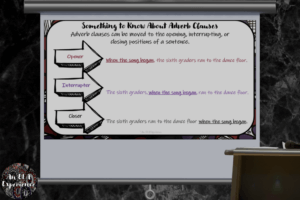
I then introduce students to the aaawwubbis, a mnemonic that helps them remember commonly used subordinating conjunctions (as, after, although, when, while, until, before, because, if, since). When a sentence begins with one of these words, they’re probably going to need a comma. To help them memorize these words, we cheer for them often while we’re studying adverb clauses.
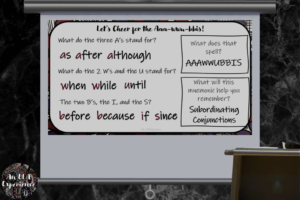
I end the slideshow presentation by directing students to spend the rest of the period talking in complex sentences with introductory adverb clauses. This allows them to become familiar with the sound and rhythm of these sentences.

Adverb Clause Practice
Warms-Ups with Mentor Texts
As with other grammar-related concepts, I spend three weeks on warm-ups where students combine, imitate, and write sentences with adverb clauses. We use mentor texts for combining and imitating, and students place the clauses in the position they think works best (opening, interrupting, or closing). We then compare their responses to the authors’ sentences. (They like it when their sentences are written as the authors’ sentences, but other responses will be correct.) If they make a mistake, say a comma in the wrong place, they correct the error.
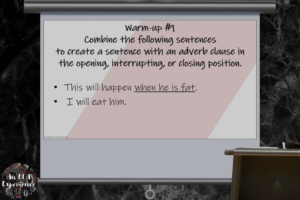
To create the warm-ups, I make notes in the margins of texts they’re reading (fiction and nonfiction). Any time I see an adverb clause, I write adv in the margin. These sentences become our warm-ups.
I separate the sentence into two sentences, adding words as needed. Take this sentence from Leigh Bardugo’s Crooked Kingdom, for example: “When fear arrives, something is about to happen.” This sentence can be made into two sentences by adding this happens to the adverb clause and copying the independent clause.
- This happens when fear arrives.
- Something is about to happen.
As mentioned in an earlier blog post, I’m a big believer in warm-ups because they give students the practice they need with just a few minutes a day.
Collecting Sentences with Adverb Clauses

At the beginning of the year, I have students tape pages into their writers’ notebooks for collecting sentences with openers, interrupters, and closers (among other things).
Then, working in groups or individually, they hunt for sentences that include adverb clauses and write them on the appropriate pages. This is easy when looking for adverb clauses in the opening position because they can scan for sentences that begin with an aaawwubbis. If the clause is a complete sentence when the subordinating conjunction is omitted, then it’s an adverb clause.
They then present their sentences to the class for discussion, noting how they know it’s an adverb clause and what position it’s in.
Sentence Scramble with Adverb Clauses
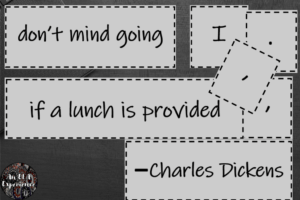
Because adverb clauses can be moved to the opening, interrupting, and closing positions of a sentence, the sentence scramble is a great hands-on activity.
To prepare for this, write complex sentences with adverb clauses (or type them in a large font) and separate them into chunks: the subject, the adverb clause, the predicate, two commas, and an end punctuation mark. (Don’t capitalize the first word of the sentence unless you want to give students a hint.)
Set these up as stations for students to rotate through. They’ll work together to put the sentence parts into the order they think works best.
Adverb Clause Worksheets and Task Cards
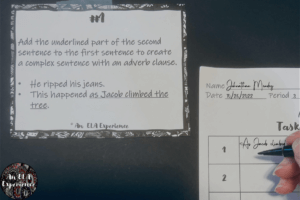
Students can practice with worksheets and task cards too by combining sentences, writing sentences, highlighting adverb clauses, moving them to different parts of the sentence, and/or noting the type of sentence (e.g., simple, complex, compound, or compound-complex).
Tape task cards to your walls and ask students to work in small groups as they rotate through the stations. For individual work, play a game of Scoot by taping the cards to student desks and having them move to the next desk every time you say, “Scoot.”
Simple, Compound, Complex, and Compound-Complex Game
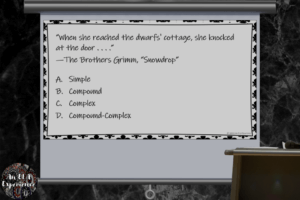
To host a game, create a slideshow. Type one type of sentence on each slide and the answer on the next slide (simple, compound, complex, and/or compound-complex sentence). Students work in groups to determine the type of sentence used. Make this even more engaging by keeping score, using buzzers, and/or having them hold up A, B, C, or D cards to indicate their responses.
Sidewalk Sentences
On beautiful Texas days, I sometimes take my students outdoors to write complex sentences (or any type of sentence we’re studying) on the sidewalks with chalk. If it’s raining, then I have them work in the hallway and write their sentences on black butcher paper. They work in small groups to write their sentences, and we work as a whole group to check their sentences.
When I Was Little, My Favorite Adverb Clause Activity
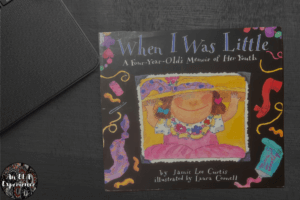
Now it’s time for the activity I’ve been wanting to share with you since I started blogging. I read about it in Jeff Anderson’s Mechanically Inclined, a book I highly recommend because of the engaging ideas.
Gather your students around you for a picture book reading of Jamie Lee Curtis’s When I Was Little: A Four-Year-Old’s Memoir of Her Youth. Have them seated close enough to see the pictures and to pass the book to their peers. (If you don’t have this book, you can find a video of it on YouTube, but you’ll find reading it much more entertaining.)
Since this is a four-year-old’s memoir, students take turns reading each page, speaking in baby voices to sound like four-year-olds. (They love this, and even the introverts will want to read a line to the class.)
Before and during the reading, point out how a comma is used after the opening adverb clause when I was little and remind them to use a comma when a sentence begins with when.
Ask them to return to their seats and brainstorm when-I-was-little sentences, making sure to use commas after the opening adverb clauses. After a few minutes, have them exchange papers with their elbow partners for a peer edit on this comma rule. End the lesson with a few volunteers sharing their sentences with the class.
To take this activity a step further, have students choose one of their sentences to write about. (This can serve as a prewriting activity for a personal narrative.)
If I Had a Million Dollars, Another Favorite to Teach Adverb Clauses
If you want to do the when-I-was-little lesson today but don’t have the book, then check out the Barenaked Ladies’ “If I Had a Million Dollars” (another idea from Jeff Anderson).
Google and print the lyrics, making sure they’re punctuated correctly, especially the adverb clauses. Then read along as you play the song, noting that sentences beginning with the subordinating conjunction if will need a comma.
As with the when-I-was-little activity, begin with brainstorming. However, in this case, students brainstorm if-then statements (e.g., If I were a monkey, I’d climb trees all day). After a few minutes, allow a few volunteers to read their lists (for engagement and inspiration). Then direct them to exchange papers with a partner for a quick peer edit. They can then choose one sentence to write about.
When teaching more than one grade level, I used the when-I-was-little activity with my seventh graders and the million-dollar one with my eighth graders, but they can be used with any secondary-level class. (I even had adults reading in baby voices at a teacher conference, and they were giggling as much as my students!)
Adverb Clause Reflecting and Assessing Activities
Exit Slips

Use exit slips after these lessons for a quick assessment (quick for you and your students). They can summarize their learning, note questions about the lesson, or write complex sentences with adverb clauses in various positions. Just give them an index card and have them answer a question. You can read through them in minutes and use them for review.
Apply Adverb Clauses to Writing
Whenever they’re writing anything while you’re teaching adverb clauses, have them underline one in their writing. If they don’t have one, then they can add one. You’ll know they’ve mastered this concept when you’re seeing complex sentences that are correctly written and punctuated.
Teaching Adverb Clauses (in a Nutshell)
To introduce complex sentences with adverb clauses, use anchor charts and a slideshow.
Use any or all of the following for practice:
- Daily warm-ups
- Sentence collecting
- Sentence scramble
- Worksheet or task cards
- A game
- Sidewalk sentences
- When I Was Little and/or “If I Had a Million Dollars”
For assessing and reflecting, try exit slips and make sure they apply this concept to their writing.
Related Links
Blog #1: Easy Introductory Activities for Teaching Students How to Use the Comma
Blog #9: Teaching Students to Edit a Little Every Day
Khan Academy’s Complex Sentences (video)
Khan Academy’s Subordinating Conjunctions (video)
Daily English Warm-Ups for Complex Sentences (my TPT store)
Exercises on Complex Sentences (my TPT store)
Exercises for Complex Sentences with Adverb Clauses–Task Cards (my TPT store)
Thank you for reading! If you have any questions about adverb clauses, leave a comment for me.


